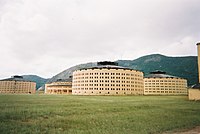Isla de la Juventud
Isla de la Juventud[1] (lit. Isle of Youth; until 1978 named Isla de Pinos – Pine Island) is the second-largest Cuban island and the sixth-largest island in the West Indies. The island has an area 3056 km² (1180 square miles) and is 100 km south of the island of Cuba, across the Gulf of Batabanó. The island lies almost directly south of Havana and Pinar del Río, and because of its superficial extension, population and for its economic characteristics
This article may be confusing or unclear to readers. |
, is considered to be a Special Municipality, not being a part of any province. The Isle of Youth is, therefore, administered directly by the central government of Cuba.
The largest of the 350 islands in the Canarreos Archipelago (Archipiélago de los Canarreos), the island has an estimated population of 100,000. The capital and largest city is Nueva Gerona in the north, and the second-largest and oldest city is Santa Fe in the interior. Other communities include Columbia, Mac Kinley, Santa Bárbara, Cuchilla Alta, Punta del Este, Sierra de Caballos and Sierra de Casas. The island was called the Isle of Pines (Isla de Pinos) until being renamed in 1978.
History
Little is known of the pre-Columbian history of the island, though a cave complex near the Punta del Este beach preserves 235 ancient drawings made by the native population. The island first became known to Europeans during Christopher Columbus's third voyage to the New World in 1494. Columbus named the island La Evangelista and claimed it for Spain; the island would also come to be known Isla de Cotorras ("Isle of Parrots") and Isla de Tesoros ("Treasure Island") at various points in its history.
Pirate activity in and around the area left its trace in English literature. Both Treasure Island by Robert Louis Stevenson and Peter Pan by James Matthew Barrie are rooted in part on accounts of the island and its native and pirate inhabitants, as well as long dugout canoes (which were often used by pirates as well as indigenous peoples) and the great American crocodile (Crocodylus acutus) on the island.
Following the victory of the United States in the Spanish-American War, Spain dropped all claims to Cuba under the terms of the 1898 Treaty of Paris. Isla de la Juventud was not mentioned in the Platt Amendment, which defined Cuba's boundaries, and this led to competing claims to the island by the United States and the now-independent Cuba. In 1907, the U.S. Supreme Court decided that the island did not belong to the United States. A treaty was signed between the U.S. and Cuba in 1925, recognizing Cuban ownership.
Geography and economy

Much of the island is covered in pine forests, which is the source of the island's large lumber industry. The northern region of the island has low ridges from which marble is quarried, while the southern region is an elevated plain. Agriculture and fishing are the island's main industries, with citrus fruit and vegetables being grown. A black sand beach was formed by volcanic activity.
The island has a mild climate, but is known for frequent hurricanes. It is a popular tourist destination, with many beaches and resorts, including Bibijagua Beach. Until the Cuban government expropriated all foreign-owned property in the early 1960s, much land was owned by Americans.
Demographics
In 2004, the province of Isla De La Juventud had a population of 86,637.[2] With a total area of Template:Km2 to mi2,[3] the province had a population density of Template:Pop density km2 to mi2.
Transportation
The main transportation to the island is by boat or aircraft. Hydrofoils (kometas) and motorized catamarans will make the trip in between two and three hours. A much slower and larger cargo ferry takes around six hours to make the crossing, but is cheaper. The province has only one municipality, also named Isla de la Juventud.
Prisons

From 1953 to 1955, Cuban leader Fidel Castro was imprisoned in the Presidio Modelo on the Isla de la Juventud by the regime of Fulgencio Batista after leading the failed July 1953 attack on the Moncada Barracks in the Oriente Province. After the triumph of the Revolution, the same facility was used to imprison counterrevolutionaries, homosexuals and people allegedly otherwise opposing the right socialistic state of mind. Huber Matos (once a comandante of rebel troops supporting the Cuban Revolution and later an opponent of the Revolution) and Armando Valladares have been imprisoned here. Matos says he was tortured there [4].
Presidio Modelo is now closed, and turned into a museum. It is replaced by more modern prisons. These include (MAS = maximum security prison; COR = correctional):
- Prison El Guayabo (MAS)
- Center for Reeducation of Minors (COR)
- Correctional Los Colonos (COR)
- Paquito Rosales Cueto (1 y 11) (COR)
- Prison la 60 (Columbia) (COR)
References
- ^ Directorate of Intelligence (2007-08-16). "The World Factbook - Cuba". Retrieved 2007-09-03.
{{cite web}}: Check date values in:|date=(help) - ^ Atenas.cu (2004). "2004 Population trends, by Province and Municipality". Retrieved 2007-10-02. Template:Es icon
- ^ Government of Cuba (2002). "Population by Province". Retrieved 2007-10-02. Template:Es icon
- ^ American Experience | Fidel Castro | People & Events | PBS
